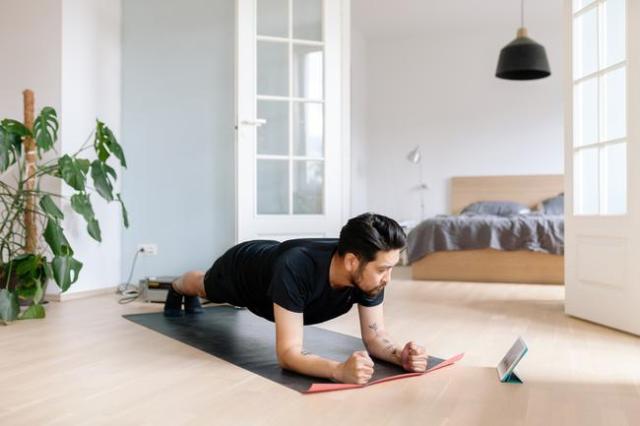
The past year has shown the limits of self-improvement culture in many ways. You can’t change the government’s response to coronavirus with a new habit. A shift in mindset will not make that guy wear a mask.
At the same time, it’s never been more important to fight back to protect your physical and mental well-being where you can. You can’t control the broader course of the pandemic, but you can control how you respond to it. It’s not a secret that lots of people have responded to it by stress-eating, doom scrolling, and working from the couch. No judgment here! It’s been incredibly hard. But the new year is a great opportunity to take stock of the new patterns you’ve fallen into and consider whether you would like them to change.
To help you do that, we talked to a panel of experts about five ways to help you undo the damage of 2021 lockdowns—or at least the stuff that’s undoable.

Fix Your Posture
If you’re fielding dawn-to-dusk Slacks in the same place you’re watching back-to-back episodes of The Queen’s Gambit, your posture may have taken a beating. “Our bodies like to move,” says physical therapist Miguel Almario, “and being stuck sitting for work or sitting on the couch binging TV can potentially affect your ability to perform the activities you like to do.”
If you’re rapidly becoming the Hunchback of Apartment 4B, try adding some motion. Almario recommends starting with three sets of 10 glute bridges, three times per week, which will get the hips moving better. Then bang out some push-ups. “They can help with getting you loose after sitting hunched forward,” he adds. “Focus on the slow lowering of your body to the floor, and then explode up.”
But more than any particular movement, the key is simply moving more regularly. As a rule of thumb, for every hour you sit, you should move for two minutes, Almario says. “Set a timer for the hour, and when it hits, go for a walk around the block—throw in a few squats or jumping jacks. Anything is better than nothing!”

Think Positively (Even If You Have to Force It)
If you’re feeling a little down on yourself and the current state of things, you are not alone. And the power of positive thinking is not a cure-all, especially for serious mental-health issues.
However, there’s a lot of power in making a conscious choice to seek out the silver lining. In fact, research has found that structured positive thinking reduces anxiety, increases positive emotions, and might even be beneficial for your immune system.
So start your day on the right foot by scheduling an achievable goal for each day, recommends Leela R. Magavi, M.D., a psychiatrist and the regional medical director for Community Psychiatry. “Scheduling in advance and creating routines transform healthy behaviours into positive habits,” she says. “This could be as simple as a mindful walk on a busy day.” Try writing down what you’re going to do before you go to sleep, or try “stacking” a new habit onto something you already do. (For example, if you make coffee every day, make that the time you write down five things you’re grateful for.)
Magavi suggests consciously making note of all the small, good choices you make in the course of a day. “Every healthy behaviour can be perceived as a win,” she says, “like choosing to drink water instead of soda.” You also don’t have to go it alone. Magavi recommends calling in some reinforcements to help boost the mood. Having a standing check-in with an accountability partner, like a friend or family member, can hold you to a routine of proven mood-boosting habits like deep breathing or regular exercise.

Move Your Reps In
Group fitness classes are cancelled. Gyms are either closed or dangerous. There are no marathons or triathlons to train for. Lacee Lazoff, a kettlebell expert and the founder of Bells Up, says none of that matters now. “Instead of judging where you’re at, you owe it to yourself to be realistic with what you can do right now, what tools are available to you, and get moving.”
The most important thing is to find something that you actually enjoy: “That’s something that you’re likely to actually do,” she says. Resolve to play around with some new options—YouTube yoga, a new app, or just a jog around the block.
She also suggests finding some sort of a workout routine for the week that you can integrate into your schedule and commit to it like a meeting. But this doesn’t mean an inflexible 90-minute block. “It could be small touches of movement throughout the day, like 20 minutes in the morning, afternoon, and night,” she says.

Drink Enough Water
Every day, you should shoot to consume between 25 and 50% of your body weight in ounces of water. It’s simple enough, but many people simply forget.
Alissa Rumsey, a registered dietitian, certified intuitive-eating counsellor, and the author of Unapologetic Eating, recommends making your hydration situation more convenient all around. Start by keeping a glass of water at your bedside and drinking it as soon as you wake up, so that you’re starting off the day less dehydrated. Then try keeping a large bottle on your desk. “That way, even if you refill just once, you’ll still be drinking at least six-ish glasses of water during the workday.”
And remember: Still, sparkling, and flavoured waters all “count” as hydration, as do other fluids such as tea, milk, and even coffee.

Eat More Intentionally
Whether you have a specific weight-loss goal or are just trying to cut down on 4 p.m. cookie binges that leave you feeling crappy for the rest of the day, it’s worth figuring out how to eat with a little more intention.
“In a stressful year, a lot of us are turning to emotional eating from the stress we are dealing with,” says registered dietitian and personal trainer Kelli Fierras. “When we are stressed, our cortisol levels will increase, causing an increase in appetite, and in turn, this response may manifest as cravings.”
If this sounds familiar, first go all the way to the root of the problem—the stress. If we focus on stress minimization, we may be able to curb that sweet tooth, says Fierras. Simple, proven practices like deep breathing and regular exercise are a great place to start.
Second, be sure you’re feeding yourself enough. Another reason that you could be reaching for your 12th Oreo of the day could be because you’ve actually gone too long without eating a legit, balanced meal. “When we don’t consume enough protein, carbs, and fat throughout the day, our blood sugar can decrease at an abnormal rate, causing one to crave energy from sugary foods,” she says.
To keep everything in balance, Fierras recommends eating every two to four hours throughout the day. Lastly, know thyself: Make sure you have snacks you enjoy but also want to be eating on hand.








